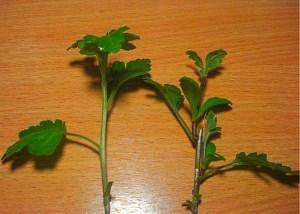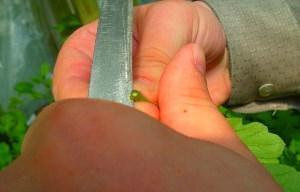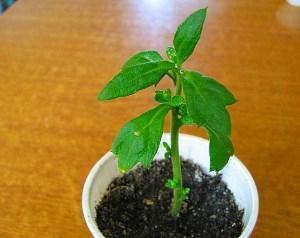Cutting chrysanthemums is the best way to reproduce
 When growing chrysanthemums from seeds, the loss of their varietal characteristics is often noted. The most reliable way to reproduce valuable varieties in large quantities is considered to be cuttings. This method is a type of vegetative propagation. The Korean chrysanthemum, popular in recent years, is sometimes propagated by dividing the bush. Moreover, the percentage of its reproduction is quite low. Chrysanthemum cuttings of this species root easily and retain all the specific features of the original plant. Thanks to this method, any interesting variety can be quickly propagated.
When growing chrysanthemums from seeds, the loss of their varietal characteristics is often noted. The most reliable way to reproduce valuable varieties in large quantities is considered to be cuttings. This method is a type of vegetative propagation. The Korean chrysanthemum, popular in recent years, is sometimes propagated by dividing the bush. Moreover, the percentage of its reproduction is quite low. Chrysanthemum cuttings of this species root easily and retain all the specific features of the original plant. Thanks to this method, any interesting variety can be quickly propagated.
"Early" cuttings are those that are grown in winter (January-February) with short daylight hours. They take root within 1 month. "Late" cuttings, obtained in April-May, develop roots in 1-2 weeks.
Features of the reproduction of chrysanthemums by cuttings
The rooting of cuttings and the growth of these flowers have certain characteristics:
- small-flowered plants take root much faster than large-flowered ones;
- varieties in which fleshy and thick shoots take root much worse;
- plants of the same variety when grown from "early" and "late" cuttings enter the flowering period almost simultaneously;
- the propagation period strongly affects only the size of the plant (very tall stems grow from the "early" shoots).
How to propagate chrysanthemums by cuttings?
The process of reproduction of chrysanthemums begins with the selection of the best of their kind adult plants, called mother plants.
In autumn, healthy shrubs with perfect inflorescences are chosen. They should not show any signs of disease or pests. At the end of flowering, mother liquors are dropped in greenhouses or transplanted into boxes. Chrysanthemum bushes are left in a cool place, protected from excess moisture. Closed terraces, verandas or light sheds are suitable for storing them. The storage location for mother liquors depends on the level of winter temperature. Ideal conditions for a period of physiological rest chrysanthemums is in the range of 3-5 ° C. The basic rule for their successful preservation is that these flowers should not be at temperatures less than 1 ° C.
To obtain young plants with an excellent flowering level, it is necessary to vernalize the mother plants. For this, the plants are kept in rooms with a temperature of 1-4 ° C for 3-4 weeks. The absence of such a procedure often leads to the fact that some varieties of chrysanthemums never bloom.
To obtain good planting material, mother plants are transferred to a warm, lighted room and watered regularly. A few days later, renewal buds awaken on their roots. At the same time, root shoots begin to grow from the mother liquor. The effectiveness of cuttings depends entirely on the amount of new growth. To obtain a sufficient number of plants, mother plants begin to prepare for cuttings in February. Most often, this procedure is performed in early spring.

How to cut chrysanthemums?
The root shoots are cut with a sharp knife under the leaf node, when 2-3 internodes are formed on it. The resulting cuttings are planted in boxes or low pots with a fertile substrate with a neutral reaction. It is prepared from fertile soil, humus and sand, taken in a ratio of 2: 1: 0.5. The thickness of the substrate should be 3-4 cm. Calcined sand is poured on top of it. Its layer should be 2-2.5 cm. You can also use a mixture of perlite and coarse sand in a 1: 1 ratio. This substrate has a high moisture capacity and breathability.
For quick rooting of cuttings, they are treated with a solution of a root formation stimulator. To do this, use the drug "Kornevin" or alpha-naphthylacetic acid (NAA).
 The cuttings are buried in the substrate to a depth of 2.5-3 cm. The optimum temperature for rooting cuttings is 18-20 ° C. In the room used for rooting cuttings, it is necessary to maintain an optimal microclimate. To do this, a "dome" is made over the container from a polyethylene film that provides the necessary air humidity.
The cuttings are buried in the substrate to a depth of 2.5-3 cm. The optimum temperature for rooting cuttings is 18-20 ° C. In the room used for rooting cuttings, it is necessary to maintain an optimal microclimate. To do this, a "dome" is made over the container from a polyethylene film that provides the necessary air humidity.
Growing
Caring for cuttings consists in spraying them daily and watering them regularly. Successful rooting is evidenced by the appearance of growth on the shoot. Plants can be fed with nitrogen fertilizer. About 1 month after the start of rooting of the cuttings, the root system develops on them. After it becomes powerful enough, new plants are planted in open ground. This happens most often in May-June.
 In the case when the rooted shoots cannot be planted in open ground due to the possibility of frost, they are kept in rooms with an air temperature of 8-10 ° C. In such conditions, the "overgrowth" of the cuttings will be prevented. They are planted in a permanent place only after there is no threat of spring frosts. If it is not planned to root the cuttings immediately after cutting, then they are placed in a container with water.
In the case when the rooted shoots cannot be planted in open ground due to the possibility of frost, they are kept in rooms with an air temperature of 8-10 ° C. In such conditions, the "overgrowth" of the cuttings will be prevented. They are planted in a permanent place only after there is no threat of spring frosts. If it is not planned to root the cuttings immediately after cutting, then they are placed in a container with water.
Cuttings of large-flowered chrysanthemums are carried out from January to April, and small-flowered chrysanthemums - from February to the end of May. Reproduction of chrysanthemums in autumn involves the planting of rooted cuttings in late May and early summer. In this case, the early flowering of a young bush will be the next year.